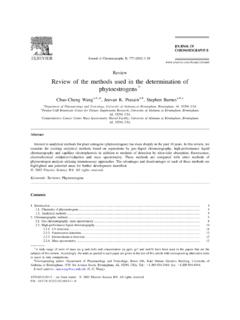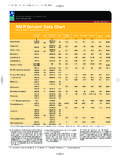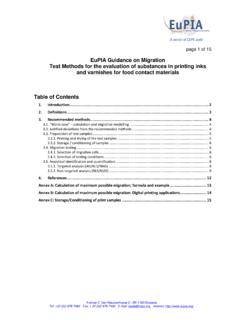Transcription of PRESCRIBING INFORMATION - Paladin Labs Inc.
1 PRESCRIBING INFORMATION . cortifoam . Hydrocortisone Acetate USP 10%. Rectal Anti-Inflammatory Corticosteroid Foam Paladin Labs Inc. Date of Preparation: 6111 Royalmount, Suite 102 July 7, 2009. Montr al, Qu bec Version: H4P 2T4. Control No: 131117. PRESCRIBING INFORMATION . NAME OF DRUG. cortifoam . (Hydrocortisone Acetate USP 10%). THERAPEUTIC CLASSIFICATION. Rectal Anti-Inflammatory Corticosteroid Foam ACTION AND CLINICAL PHARMACOLOGY. The action of cortifoam (hydrocortisone acetate USP 10%) appears to be due to a local anti-inflammatory effect of hydrocortisone acetate on the mucosa rather than as a result of a systemic effect due to absorption of hydrocortisone.
2 INDICATIONS. cortifoam (hydrocortisone acetate USP 10%) is indicated as adjunctive therapy in the treatment of ulcerative colitis of the sigmoid colon, proctosigmoiditis, granular proctitis and ulcerative proctitis. CONTRAINDICATIONS. Contraindications to the use of intrarectal steroids include obstruction, abscess, perforation, peritonitis, fresh intestinal anastomoses, extensive fistulas and sinus tracts. Tuberculosis (active, latent or questionably healed), ocular herpes simplex, varicella, vaccinia, and acute psychosis are usually considered contraindications to the use of corticosteroids. Other contraindications include active peptic ulcer, acute glomerulonephritis, myasthenia gravis, osteoporosis, diverticulitis, thrombophlebitis, psychic disturbances, pregnancy, diabetes, hyperthyroidism, acute coronary disease, hypertension, limited cardiac reserve, and local or systemic infections, including fungal or exanthematous diseases.
3 Where these conditions exist, the expected benefits from steroid therapy must be weighed against the risks involved in its use. cortifoam (hydrocortisone acetate USP 10%) is also contraindicated in systemic fungal infection and in the presence of hypersensitivity to any of its components. 2. WARNINGS. CAUTION: Contents are flammable and the aerosol container may explode if heated. Do not insert any part of the aerosol container into the anus. Do not use in presence of an open flame or spark. Contents of the container are under pressure. Do not refrigerate. Do not place in hot water or near radiators, stoves or other sources of heat. Do not incinerate or puncture the aerosol container or store at temperatures over 50 C.
4 Because cortifoam (hydrocortisone acetate USP 10%) is not expelled, systemic hydrocortisone absorption may be greater from cortifoam than from corticosteroid enema formulations. If there is no evidence of clinical or proctologic improvement within two or three weeks after starting cortifoam therapy, or if the patient's condition worsens, discontinue the drug. Signs and symptoms of intestinal perforation and peritonitis may be difficult to detect during corticosteroid treatment. PRECAUTIONS. General: A complete rectal examination to rule out serious pathology and extension of the disease process should be completed before instituting therapy.
5 Do not use on infected lesions unless accompanied with anti-infective agents. Steroid therapy should be administered with caution in patients with severe ulcerative disease because these patients are predisposed to perforation of the bowel wall. Where surgery is imminent, it is hazardous to wait more than a few days for a satisfactory response to medical treatment. General precautions common to all corticosteroid therapy should be observed during treatment with cortifoam (hydrocortisone acetate USP 10%). These include gradual withdrawal of therapy to allow for possible adrenal insufficiency and awareness of possible growth suppression in children.
6 Patients should be kept under close observation, for as with all drugs, rare individuals may react unfavorably under certain conditions. If severe reactions or idiosyncrasies occur, steroids should be discontinued immediately and appropriate measures instituted. Do not employ in immediate or early postoperative period following ileorectostomy. Patients should be advised to inform subsequent physicians of the prior use of corticosteroids. Use in Pregnancy: Steroids should not be used during pregnancy since safety during pregnancy has not been fully established. 3. If corticosteroids must be administered during pregnancy, particularly during the third trimester, the newborn infant must be observed closely for signs of hypoadrenalism, and the appropriate therapy administered if needed.
7 Nursing Mothers: Mothers using cortifoam should be advised not to nurse. ADVERSE REACTIONS. Corticosteroid therapy may produce side effects which include moon face, fluid retention, excessive appetite and weight gain, abnormal fat deposits, mental symptoms, hypertrichosis, acne, ecchymosis, increased sweating, pigmentation, dry scaly skin, thinning scalp hair, thrombophlebitis, decreased resistance to infection, negative nitrogen balance with delayed bone and wound healing, menstrual disorders, neuropathy, peptic ulcer, decreased glucose tolerance, hypokalemia, adrenal insufficiency, necrotizing angiitis, hypertension, pancreatitis and increased intraocular pressure.
8 In children, suppression of growth may occur. Increased intracranial pressure may occur and possibly account for headache, insomnia and fatigue. Subcapsular cataracts may result from prolonged usage. Long-term use of all corticosteroids results in catabolic effects characterized by negative protein and calcium balance. Osteoporosis, spontaneous fractures and aseptic necrosis of the hip and humerus may occur as part of this catabolic phenomenon. Where hypokalemia and other symptoms associated with fluid and electrolyte imbalance call for potassium supplementation and salt poor or salt-free diets, these may be instituted and are compatible with diet requirements for ulcerative proctitis.
9 Local effects of itching and burning have been reported following rectal use. SYMPTOMS AND TREATMENT OF OVERDOSAGE. Symptoms: Acute toxicity, even with massive doses is not a clinical problem. Chronic toxicity involves manifestations of the physiologic effects described above and include Cushingoid appearance, muscle weakness, osteoporosis, posterior subcapsular cataracts, peptic ulcers, hypertension, psychosis, and growth suppression in children. Glaucoma, pancreatitis, reactivation of tuberculosis and poor wound healing may occur. Sodium and fluid retention with potassium loss occur to varying degrees, depending upon the mineralocorticoid effects of the particular corticosteroid.
10 Treatment: Acute overdosage probably requires no treatment. Acute overdosage requires no tapering as in withdrawal of patients on long-term administration. If there is any question that other drugs have 4. been ingested simultaneously, then standard measures for those drugs should be followed as per instructions for their management. 1) Avoid chronic dosage for durations greater than 3 weeks when possible. 2) When chronic dosage for periods greater than 3 weeks is essential, attempts should be made to manage the underlying disease if possible with alternate day dosage using single daily doses on alternate mornings of shorter acting preparations such as prednisone, prednisolone or methylprednisolone.






![Pharmacopeial Forum Vol. 35(5) [Sept.–Oct. 2009] …](/cache/preview/4/f/6/4/6/b/d/9/thumb-4f646bd9c98fa61ae166a740ef65637c.jpg)



